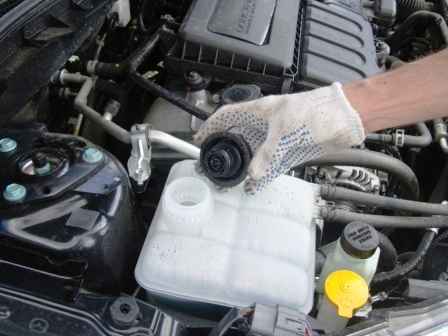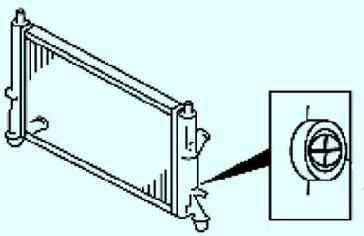Mazda 3 coolant change
Measure the temperature of the coolant and its density with a thermometer and a hydrometer.
The engine has aluminum components that can be damaged by methanol or alcohol based antifreeze.
Do not use alcohol or methanol in the cooling system
Use only ethylene glycol based coolant.
Use only soft (demineralized) water to dilute antifreeze.
Mineralized water reduces the effectiveness of the coolant.

Determine the required composition of the coolant using the diagram below (fig. 1).
If the coolant composition is not correct, add water or antifreeze.
Replacing engine coolant
Stop the engine and let it cool down. Even so, care must be taken when removing the cover.
Wrap a thick cloth around the lid and slowly turn it counterclockwise to the first stop.
Move away from the radiator while depressurizing.

When you are sure that the pressure has been relieved, press down on the cap, wrapping it with a cloth, twist and remove it.
Engine coolant damages paintwork.
If engine coolant comes into contact with a painted surface, wash it off immediately.
Remove the cap of the expansion tank of the cooling system (fig. 2).
Remove the bottom cover.

Remove the radiator drain plug and drain the engine coolant into a container (fig. 3).
Rinse the cooling system with pressurized water until the outlet water becomes discolored.
Let the water drain completely from the system.
Tighten the radiator drain plug. Tightening torque: 1.2 - 1.5 Nm.
Add coolant to the expansion tank of the cooling system up to the maximum mark. Install the cooling system cover.
If the coolant temperature gauge needle enters the red zone, stop the engine and wait until it cools down to prevent overheating.
After that, identify the defective element and repair or replace it.
Start the engine and let it idle until the temperature gauge is at the center of the scale and the engine speed is less than 1500 min–1.
After the engine has warmed up, do the following while monitoring the engine coolant temperature with a thermometer.
Let the engine run for 2500 min-1 for 5 min.
Let the engine run for 3000 min-1 for 5 seconds and then let it idle.
Run the engine again for 3000 min–1 for 5 seconds twice.
Stop the engine and let it cool down.
Check the coolant level.
If the level is low, add coolant to the expansion tank of the cooling system up to the maximum mark.
Check for coolant leaks.
If there is a leak, identify the defective part and repair or replace it.











